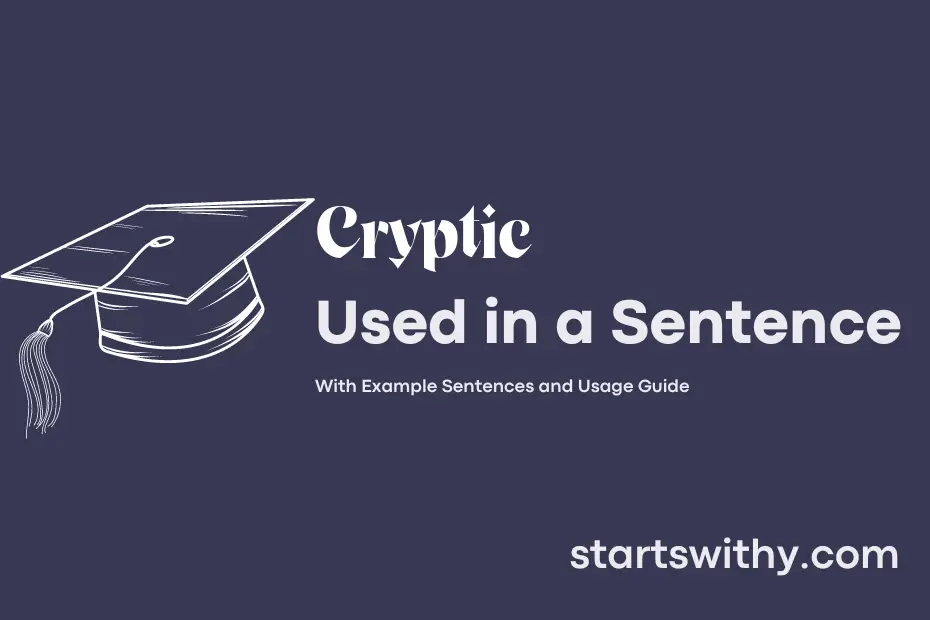Have you ever come across a cryptic message that left you puzzled and intrigued? In the realm of language and communication, a cryptic sentence is one that is mysterious, obscure, or difficult to interpret at first glance.
A cryptic sentence often requires careful deciphering or decoding to uncover its true meaning. These enigmatic phrases can be found in puzzles, riddles, ciphers, or even everyday conversations, adding an element of challenge and intrigue to the task of understanding them.
7 Examples Of Cryptic Used In a Sentence For Kids
- Cryptic messages are like secret puzzles to solve.
- The detective found a cryptic clue hidden in the bushes.
- The ancient map was filled with cryptic symbols and drawings.
- Can you decipher the cryptic code written on the wall?
- The treasure map had a cryptic riddle leading to the prize.
- The old scroll had a cryptic message written in an unknown language.
- The mystery box contained a cryptic note hinting at a hidden treasure.
14 Sentences with Cryptic Examples
- Cryptic messages on the notice board left the students puzzled.
- The professor’s handwriting in the textbook was quite cryptic.
- The clues for the treasure hunt were intentionally made cryptic.
- Solving cryptic crossword puzzles is a popular pastime among some students.
- The graffiti on the walls seemed to contain a cryptic message.
- The warning from the seniors about the upcoming exam was rather cryptic.
- The meaning behind the professor’s enigmatic smile was cryptic.
- The symbols on the ancient ruins appeared to be cryptic hieroglyphs.
- The instructions for the lab experiment were unnecessarily cryptic.
- The cryptic email from the administration caused a stir among the students.
- The riddles in the mystery novel were delightfully cryptic.
- The hidden meanings in the artwork were intentionally cryptic.
- The whispered conversations in the library sounded cryptic.
- The final question in the quiz was a cryptic one that stumped many students.
How To Use Cryptic in Sentences?
Cryptic simply means mysterious or difficult to understand. When using the word cryptic in a sentence, it is important to convey a sense of obscurity or hidden meaning.
For example:
– The message he left was so cryptic that no one could decipher its true meaning.
– Her cryptic smile revealed nothing about her true emotions.
– The ancient symbols on the wall were cryptic, leaving archaeologists puzzled about their significance.
When incorporating the word cryptic in your writing, aim to create a sense of intrigue or mystery. This will engage your readers and prompt them to think more deeply about the subject at hand. Try using cryptic in scenarios where something is not immediately clear or easily understood, adding an element of suspense or curiosity to your work.
Remember, using cryptic effectively in a sentence involves setting a tone of secrecy or complexity. By practicing and experimenting with different contexts, you can master the art of incorporating cryptic into your writing.
Conclusion
In conclusion, sentences with cryptic messages often contain hidden meanings or puzzles that require careful deciphering to understand their true intent. These enigmatic sentences challenge readers to think critically, dissecting each word and phrase to uncover the hidden message within. From riddles to coded languages, cryptic sentences add an element of mystery and intrigue to written communication, inviting readers to engage in a mental puzzle-solving experience.
Whether used for entertainment, conveying secrets, or challenging the intellect, sentences with cryptic messages showcase the creativity and complexity of human language. By prompting readers to explore beyond the surface, these cryptic sentences foster curiosity, creativity, and critical thinking skills, making them a fascinating aspect of linguistic communication.



